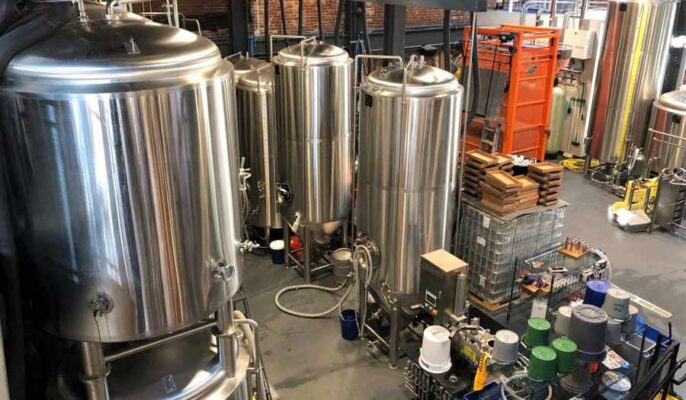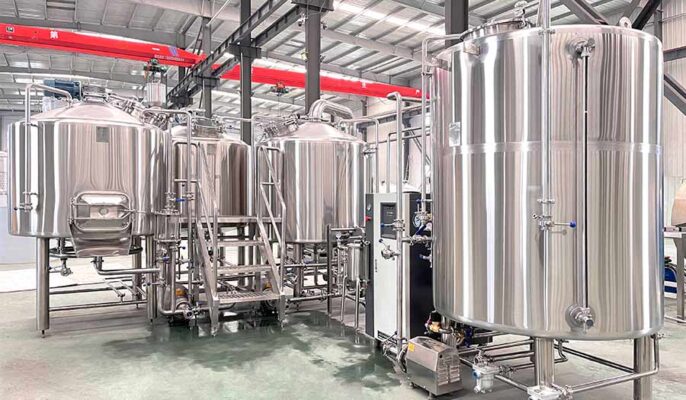A draft beer brewing system is an important part of any pub or restaurant that serves beer on tap, a kegerator or draft beer system consists of a series of components that work together to give you a poured pint. These systems are designed to keep your beer fresh and at the perfect temperature. The beer brewing process includes brewery process, fermentation process, wine storage process and canning process. When you’re considering installing a draft beer system (or redesigning an existing system) in your restaurant, bar, pub, or brewery, it’s worth understanding the different types of beer systems so you can decide which one is best for you and your beer.
What is a draft beer system? How does it work?
A draft beer system is a collection of devices and equipment used to serve beer, wine, or other beverages from pressurized kegs. The most important part of the ventilation system is the keg, which is a cylindrical container that holds the product under pressure. A basic draft beer system consists of a keg, CO2 tank, and coupler. Most tow systems also include a regulator to control the flow of carbon dioxide into the keg, and a connector to connect the keg to the tow line.
More complex draft beer systems may also include a draft beer tower that allows many kegs to be connected and a glycol cooler that helps keep the draft beer line cold. Draft systems vary in complexity, but all share these basic components. Draft beer systems are used in most bars and restaurants.

Types of Draft Beer Systems
There are three standard systems for draft beer dispensing: keg system, direct draw system and long draw system. All three systems use similar draft beer equipment, but each system has its own unique components for conveying or cooling draft beer as it travels from keg to tap.
Barrel system
The keg is a direct-draft, air-cooled tap system used in conjunction with a refrigeration unit to store and dispense beer kegs. It’s a popular choice among bar owners and restaurants because it provides a convenient way to keep beer kegs at a constant temperature.
Keggers are also great for home use as they allow beer lovers to enjoy fresh draft beer in the comfort of their own home. There are a variety of keg loaders on the market, ranging from small single-tap units to large multi-tap units. If you are interested in purchasing a kegerator, it is crucial to consider the size of the unit, the number of faucets, and the type of refrigeration.
Components:
- Carbon dioxide tank
- Main regulator
- Gas mixer
- Secondary regulator
- Beer production line
- Bucket coupler
- Forced blower
- Return air duct
- Cold air duct
- Draft tower
- Drip tray

Direct extraction system (Kegerator)
This is the most common and simplest draft beer system used to deliver draft beer from a keg to a tap over a short distance. It is preferred for bars where beer kegs are located within a few feet of the beer dispensing tap. Most commercial keg boxes, refrigerator conversions and home bars are equipped with direct draw systems.
This type of direct draw beer system is another cheaper option for glycol cooling and has the added benefit of minimizing beer waste due to shorter beer line lengths. The cost of a direct draw beer system will vary based on the size of the equipment (kegger vs. walk-in cooler), the number of beer lines, and the quality of the installation.
Components:
- Carbon dioxide tank
- Main regulator
- Aviation routes
- Secondary regulator
- Bucket coupler
- Beer line
- Draft tower
- Faucet
- Faucet handle
Glycol cooling ventilation system
If the kegs cannot be kept refrigerated close to the ventilation tower and faucets, a long ventilation system is required. A glycol chilled draft beer system is a long draw system that uses a glycol cooler or power pack to pump a mixture of glycol and water into the main line to maintain a constant temperature of the draft beer as it travels from keg to tap. Beer is pumped from the keg in the same way as a direct extraction system using carbon dioxide or beer gas.
Long-draw systems are popular in restaurant and bar applications and offer a variety of advantages over traditional short-draw systems. If you’re looking for a way to dispense beer from a remote location, long-beverage and glycol systems are worth considering.
Components:
- Carbon dioxide tank
- Main regulator
- Gas mixer
- Secondary regulator
- Bucket coupler
- Beer production line
- Ethylene glycol trunk line
- Ethylene glycol chiller
- Draft tower
- Faucet
- drip tray
Pros and Cons of Different Draft Beer Type Systems
Kegerator system (air-cooled, direct extraction system)
Advantage
- The working principle of the simple air cooling system is to use the refrigeration of the beer barrel to provide cold air to cool the beer and the tower.
- The system is simple and easy to put in place. Installation setup time is short and easy to operate.
- This system has short line operation because the keg is located below the beer tower, which means less beer wastage during suction line cleaning and maintenance.
Shortcoming
- Storage space is limited, so you’ll need to store spare kegs in a separate walk-in cooler.
- If you want more taps, you will need to buy smaller kegs, which will need to be replaced more . The downside is that smaller kegs will increase the cost of your beer and reduce your profits.
- The number of taps is limited due to the reduced storage capacity in the bucket.
- This system takes up a lot of space behind the bar. The more taps there are, the larger the barrel loader will be.
Direct extraction system (air cooling)
Advantage
- A simple air cooling system uses the refrigeration of a walk-in cooler to provide cold air to cool the beer.
- Like the beer keg, this beer tap system is simple and easy to install and operate.
- Installation costs are usually less than the cost of long-term remote systems.
- This system has short line operation because the keg is located behind the tap in the walk-in cooler, which means less beer wastage during water line cleaning and maintenance. This equals higher profit margins.
Shortcoming
- Storage space is limited. These faucet systems often share space with produce coolers.
- You must install the bar in front of the walk-in restaurant, which limits floor plan options for architectural design.
- To maintain a proper direct draw system, sometimes you are limited in the number of taps you can install, and you do not have access to all custom beer tower options.
Long pull system
Advantage
- The long pull system gives us a wider range of options, such as cooler placement and bar placement, and does not limit your floor plan design.
- Backup storage is generally not limited by space within a remote walk-in cooler.
- This beer tap system provides more choices for bars and restaurants looking for more beer choices.
- Customers have many draft beer towers to choose from, both basic and customized.
Shortcoming
- Installation costs are usually higher than the cost of barrel loaders and direct extraction systems.
- More sophisticated glycol systems use frozen glycol from a glycol power pack. The glycol line runs within the trunk line that contains the product line. The number of glycol lines will vary based on the size of the main line.
- Unlike keg beer machines and direct drink machines, this beer tap system is complex and challenging to install, manage, and operate.
- This system may have more foam issues than the other two systems.
Choose the right beer equipment
Finally, it’s important to choose the right beer equipment for your system. This includes considering the type of beer you will serve, as well as the length of the line and the type of accessories required. It’s important to use high-quality lines and accessories to ensure your beer stays fresh and retains its flavor.
Basic brewing equipment:
- Grinding equipment
- Mash Tun
- Lauter Tun
- Boil kettle
- Filtering equipment
- Beer filling equipment
- bucket or bottle
Which draft beer system should you choose?
This involves considering the size of the bar and the number of taps you will need. For small bars, a direct draw system may be enough, while larger bars may must a long draw or remote system. If you run a small bar or want to enjoy an occasional cold glass of fresh beer at home, you should use a kegerator or short-draft draft beer system. It’s easy to use and affordable. It’s also important to consider the type of beer you’ll be serving. Different types of beer need different types of systems to serve them.
Which draft beer system to use can refer to the following points:
- What is your current beer dispensing setup?
- How far is your beer keg from the water dispenser?
- How many beers and different styles of beer do you plan to drink?
- What is your project budget?
- What is your goal?




